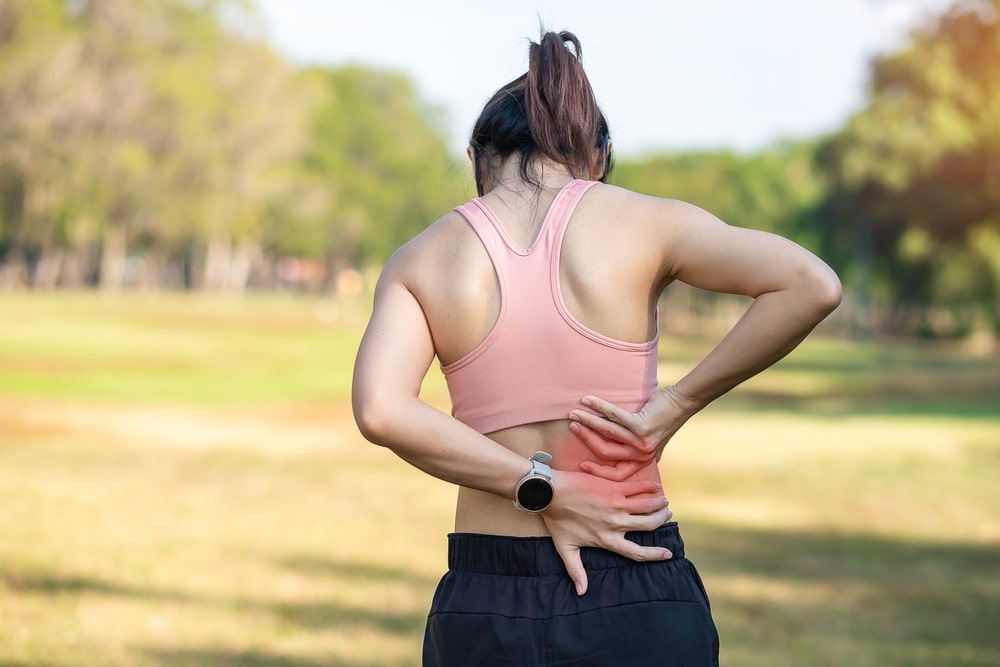Herniated disc (slipped disc)
A herniated disc, also known as slipped disc, ruptured disc, prolapsed disc or bulging disc, does not actually ‘slip’ or ‘rupture’. The spinal disc is a soft cushion that sits between each one of the 33 vertabrae (individual bony segments) of the spine. When a portion of the spinal disc pushes out (herniates) from between the vertebrae, this bulging disc may press or pinch on nearby nerves coming from the spinal cord.
This nerve pressure can cause abnormal sensations (‘electric shock’ pains), tingling, numbness, or pins-and-needles. A ruptured disc may occur suddenly in an event such as a fall or an accident, or gradually with repetitive straining of the spine
Disc Degeneration Disease (DDD)
Degenerative Disc Disease (DDD) involves a gradual deterioration of the cushiony disc between the vertebrae (bony segments) in the spine. This causes the discs and joints that stack the vertebrae (facet joints) to wear and tear over time. DDD is a very common back problem, and any level of the spine can be affected. DDD individuals tend to have constant back or neck pain, with sporadic acute pain.
DDD is also known as cervical disc disease, thoracic disc disease or lumbago, depending on the area of the spine affected. Many individuals respond well to non-operative treatments. Further diagnostic tests and surgery may be necessary for a small percentage of DDD cases.
Spinal stenosis
Spinal stenosis is a condition that is caused by a narrowing of the space surrounding the spinal cord, which places pressure on the spinal cord and spinal nerves. Common symptoms of spinal stenosis include pain, numbness, tingling and weakness. Severe cases can also cause bladder and bowel problems, which should urgently be seen by a doctor.
Spinal stenosis occurs most frequently in the lumbar (lower back) and cervical (neck) areas. In lumbar stenosis, the symptoms often affect the legs and buttocks, while in cervical stenosis, the symptoms tend to affect the arms and shoulders. This spinal problem is more common in those over age 50 and arthritis of the spine is the main cause. Severe cases of stenosis often require surgery, while non-surgical treatments may temporarily relieve pain.
Scoliosis
As the most common deformity of the spine, scoliosis is diagnosed when patients have a lateral curvature of the spine – where the vertebrae (bony segments) column bends from side-to-side, and a rotation – a twisting deformity of the vertebrae. There are several forms of scoliosis, including idiopathic scoliosis, which makes up over 80% of cases, where the cause is not known. A second type, congenital scoliosis, is caused by an abnormality in the development of the vertebrae.
Severe scoliosis that remains untreated can cause problems later in life, such as persistent back pain, and breathing or heart problems. Treatment options include observation, bracing and surgery. Spine surgery is the only way to correct scoliosis in severe cases, and the long-term results of this operation are typically very good.
Spinal tumours
Spinal tumours can involve any part of the spine from the neck down to the sacrum (back part of the bony pelvic ‘ring’). A spinal tumour is a growth or a swelling caused by the abnormal development of cells, which can be benign (non-cancerous) or malignant (cancerous). In men, spinal tumours are usually spread from the prostate or lung; in women from the breast or lung.
There are various types of spinal tumours, which can start either in the spine itself (primary tumours), or spread to the spine from other body parts (secondary or metastatic tumours). The specific cause of spinal tumours is unknown. Symptoms can include pain in or near the spine, numbness, tingling or weakness in the limbs, and problems with control of the bladder or bowels. The three main treatment options are surgery, chemotherapy and radiotherapy, depending on the type of spinal tumour.
Spinal fractures
Spinal fractures (vertebral fractures) usually result from a slip, fall or road accident, and are more common in people with osetoporosis (bone thinning) or those who play high impact sports. Major fractures can cause very damaging long-term problems if left undiagnosed and untreated. Spinal fractures cause spinal instability, high levels of pain, an increased risk of spinal cord injury, which may cause paralysis, and a lack of mobility. All spinal fractures need immediate medical attention.
- Compression fractures: These occur when the normal length of the spine is compressed, to a smaller height. The bony segments (vertebrae) in the spine collapse and becomes weakened by a series of small fractures. This causes a lot of pain and a loss of height in the individual.
- Burst fractures: Burst fractures are similar to a compression fracture, however the fractured vertebrae shatter and dislocate in all directions. Burst fractures usually occur due to a hard fall or car accident. Treatment for a burst fracture includes immobilisation and stabilisation by using a back brace or body cast, or with spinal fusion surgery.
- Fracture dislocations: These are similar to other fracture types, with the addition of two articulated surfaces (joint surfaces), being dislodged from one another. The basic treatment for fracture dislocations is also a spinal fusion operation. If the pain is severe, and collapse is becoming problematic, a vertebroplasty procedure may be used.
Kyphosis
Kyphosis is a progressive spinal disorder found in children and adults. Kyphosis involves an excessive forward curvature of the spine that often leads to a round back deformity. Left untreated, the curve progression can lead to significant problems in later life. This disorder can be present at birth, and can also result from trauma, tumours, infection, and arthritis. Kyphosis is classified as either postural or structural:
- Postural kyphosis: Postural kyphosis is caused by poor posture, which can usually be corrected by the patient. This may involve certain exercises to strengthen the patient’s muscles, and he or she must make a conscious effort to correct and maintain proper posture.
- Structural kyphosis: Structural kyphosis is caused by an abnormality affecting the bones, discs, nerves, ligaments, or muscles. Medical treatment may be needed in structural kyphosis since the patient alone cannot always control curve progression. Analgesics and anti-inflammatory medication may be used to provide relief. Padded orthoses (e.g. braces) can be used to control pain, but these do not control curve progression.
A sciatica diagnosis defines a pain that follows the sciatic nerve in the lower back. This nerve is formed from the lower segments of the spinal cord; it is made up from the lumbar and sacral nerve roots from the spine. Any irritation or compression of these nerve roots may cause a pain following the nerve distribution.
Sciatica can develop suddenly (acute), causing muscular abnormalities in the legs and thighs. Symptoms may include shooting pain, burning and tingling sensations down the leg, and partial leg numbness. The condition may also be chronic, often resulting from disc degeneration, ruptured discs, spinal instability or stenosis. The pain can settle down spontaneously without any intervention. Non-surgical treatments, such as painkillers, anti-inflammatory medication, exercise and an epidural injection can be effective. Surgery may be needed in a few cases.
Brachalgia
Brachialgia is very similar to sciatica but defines pain felt in the shoulder, arms, and hands. Brachialgia is due to problems affecting the cervical nerve roots in and around the spine. Symptoms can begin as high as the neck and sometimes the head, and many patients have severe pain in the region of the shoulder blade. Brachialgia can also settle down spontaneously without any intervention, however non-surgical treatments can also be effective. If these fail, surgical treatment may be required.




